“April showers bring May flowers,” and as the baron winter landscape slowly fades, the outdoors are once again beginning to bloom. There’s one type of flower, though, whose buds are quite ubiquitously unappreciated—dandelions. But do those hardy yellow flowers really deserve their bad reputation?

Pulling dandelions up by the roots to eradicate their existence from the front lawn was one of the chores I despised as a child. Not only was it tedious work, but it just seemed so silly. I couldn’t understand why we were getting rid of all the pretty flowers. But then I grew up. And now, as an adult, I’ve really only become even more baffled by the expectation that lawns should be free of dandelions.
Confusion breeds curiosity, and so my go-to instinct is to do some research in an effort to gain a better understanding. So, I invite you to join me on a journey to explore how dandelions got their bad rap and how we might’ve gotten dandelions all wrong.
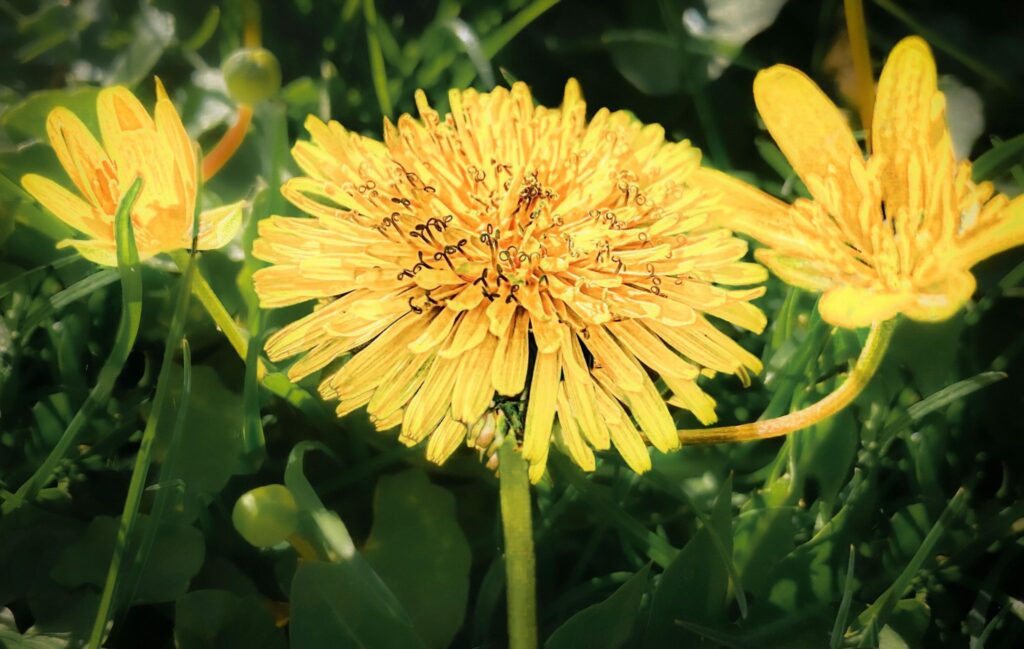
The Surprising History of Lawns
It’s easy to simply take for granted the idea that, of course, we should have pure green grass lawns, free from any dandelions. But our societal attitude toward lawns has really been shaped by a variety of influences from olden-time bougie aristocrats to chemical company propaganda to suburbanization.
The modern lawn can trace its origins back to 17th Century England when wealthy aristocrats began carpeting the land in front of their manors with seas of grass. These lawns were an intentional display of waste. At a time in which most humans toiled away in fields to put food on their plates, only the super-rich could afford to forgo cultivating their land for agriculture. So the lawn developed as a status symbol in which to flaunt one’s wealth.
By the 20th Century, lawns retained their prestigious status but started becoming more accessible to the masses. Those fancy-pants aristocrats would’ve generally hired landscapers to perform the extensive labor involved in the upkeep of their lawns. However, with new technological innovations in landscaping tools (such as the lawnmower) and chemical herbicides, the average person gained the ability to have lawns that they could personally manicure.
Along with the development of herbicides, chemical companies needed to create a market for their products. To extend their reach beyond agricultural applications, marketing campaigns were developed to advertise herbicides to the average consumer. With propaganda about the “ideal lawn,” herbicide companies sold the notion that dandelions were a nuisance that could conveniently be eliminated by buying their products. These marketing tactics were quite successful. Buying into this anti-weed messaging, Americans have been convinced to annually pour upon their lawns a staggering 80 million pounds of pesticides (including herbicides).
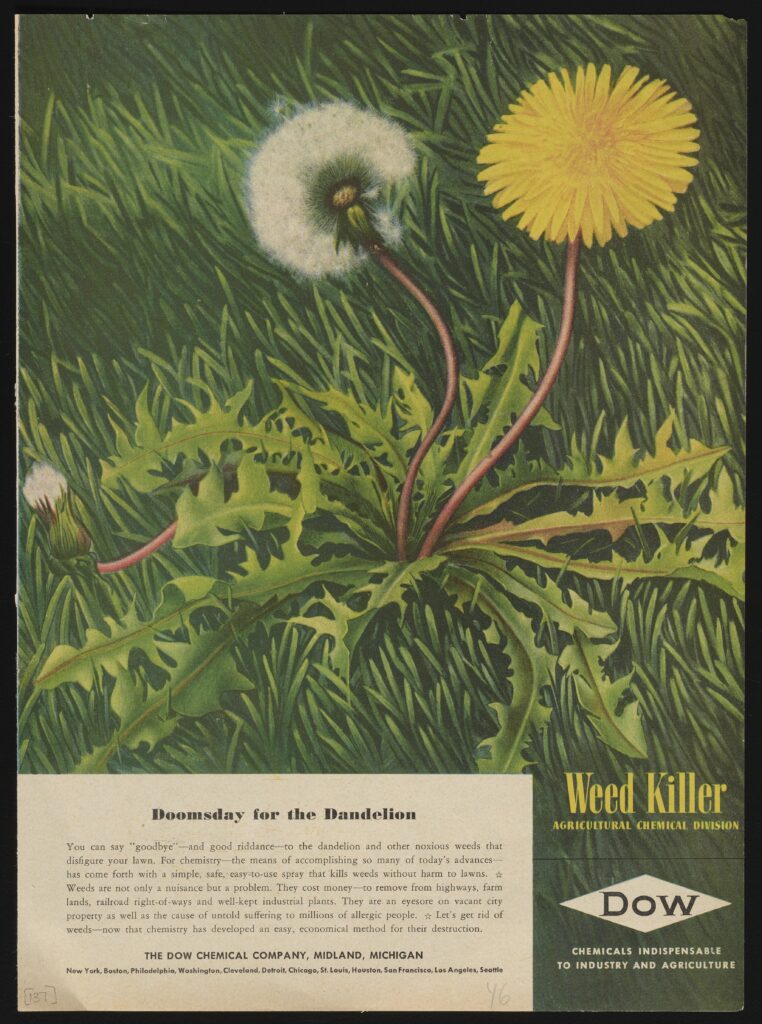 Around the same time that herbicides selectively targeting “weeds” became available, governmental policies, like FHA-backed mortgages and the creation of the Interstate Highway System, fueled the growth of the suburbs. And a major staple of the suburban home became the grass lawn. In fact, suburban lawns became such a strong symbol of aspirational desires that the “white picket fence” surrounding those lawns became part of a common description of the so-called “American Dream.”
Around the same time that herbicides selectively targeting “weeds” became available, governmental policies, like FHA-backed mortgages and the creation of the Interstate Highway System, fueled the growth of the suburbs. And a major staple of the suburban home became the grass lawn. In fact, suburban lawns became such a strong symbol of aspirational desires that the “white picket fence” surrounding those lawns became part of a common description of the so-called “American Dream.”
Just as the suburbs are notorious for their fairly homogenous, cookie-cutter style homes, there became a standard for cohesive suburban lawns as well. Beyond just a trend, suburban zoning laws and homeowners associations often set literal requirements for lawns. The consensus was that lawns were supposed to be very green. And so, an aesthetic ideal for lawns was set, and dandelions became the villain threatening to blemish the expected uniformity of one’s green grass lawn.
When Green Isn’t Green
The standard dandelion-free grass lawn isn’t just an aesthetically questionable choice depriving us of the visual beauty of pretty yellow flowers. While grass lawns, in general, are an environmental nightmare, they’re even worse when we get rid of the dandelions. So, even though grass lawns might look green, they’re actually not all that green from an eco-friendly perspective.
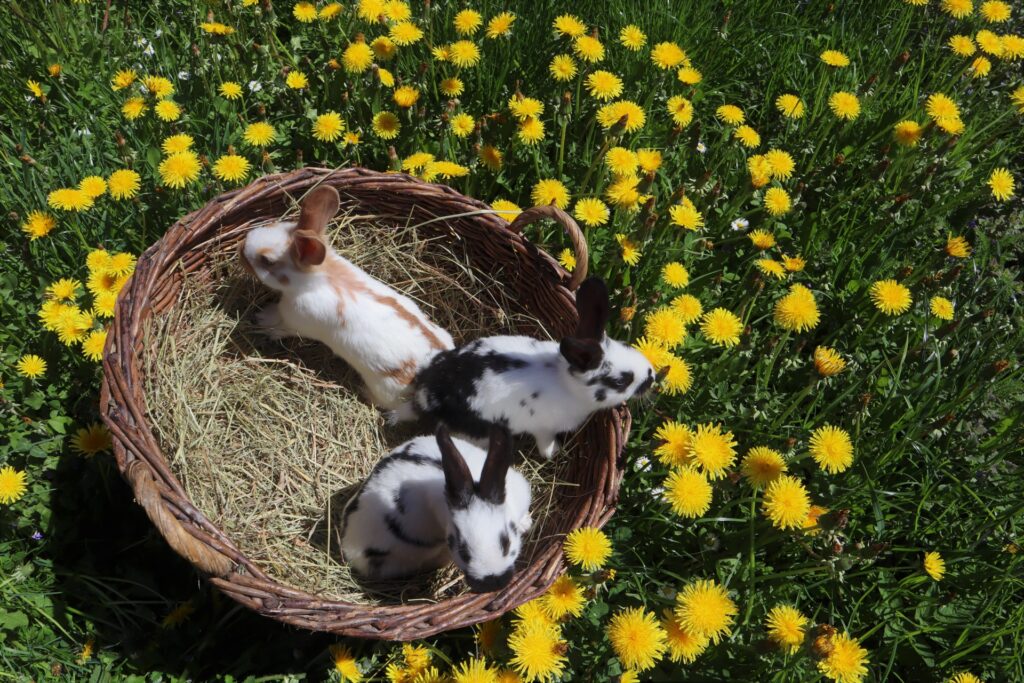
Let’s explore some of the ways in which dandelion removal is not ideal for fostering a healthy ecosystem:
Chemicals
Rather than dig out each dandelion by hand, it’s much easier to use chemical herbicides. And sadly, this is a very popular method of dandelion removal. In fact, American homes use up to 10 times the amount of herbicides per acre than are even used by farmers to protect crops. With the pervasiveness of herbicides, one in three Americans has detectable levels of toxic herbicides in their bodies. Disturbingly, these chemicals have been linked to a range of health issues including cancer, birth defects, and hormonal imbalances. Humans, though, aren’t the only animals being harmed by herbicides with research showing that it’s negatively impacting the health of wildlife as well.
Wildlife Food
A whole array of mammals, including rabbits, squirrels, and deer, obtain nutrients from eating dandelions. Our ever-important pollinator friends, including bees and butterflies, also rely on dandelions for food, especially in early spring when most other flowers have yet to bloom. By removing this source of food for wildlife, it becomes more challenging for them to obtain the sustenance that they need to survive.
Biodiversity
When we remove dandelions and other weeds from our lawns, we are left with a monoculture of only grass. And since so many animals count on dandelions for a healthy meal, dandelion-free grass lawns provide a low quality habitat that’s less capable of sustaining a diverse range of species.
Soil Health
Dandelion roots stretch deep into the earth, loosening up compact soil and preventing erosion. As their roots extend far into the dirt, dandelions also bring hard-to-reach nutrients to the surface, creating more nutritious soil in which other plants can grow. So, dandelions actually help to improve soil quality and create healthier lawns.
Ending Our Turf War With Dandelions
Perhaps it’s time to admit that our battle against dandelions just doesn’t make sense. In treating dandelions like a foe, we’ve ended up poisoning our environment with herbicides, depriving wildlife of nutritious food, reducing biodiversity, and making our soil less healthy. So let’s call a truce.
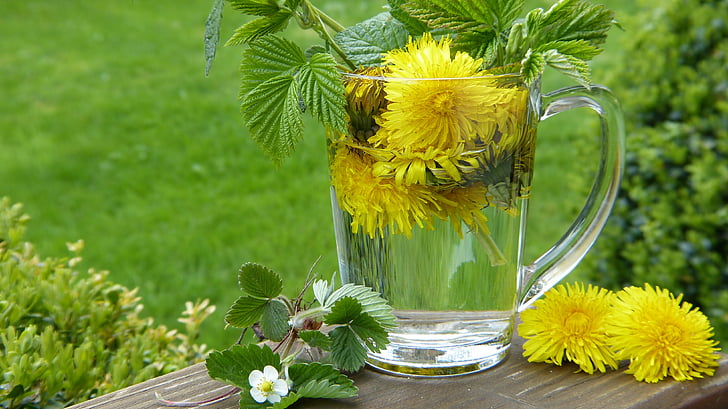
Rather than trying to keep dandelions off our lawns, we might even be better served by keeping them around to enjoy as a nutritious snack (after giving pollinators and other wildlife first dibs). Peaceful Dumpling has several recipes you can try from deep-fried dandelions to vegan-friendly dandelion “honey” and even dandelion bread.
Living side by side with dandelions, we can also simply take in their beauty. In an otherwise monotonous field of green, dandelions can really bring a sense of joy as they speckle about vibrant pops of yellow.
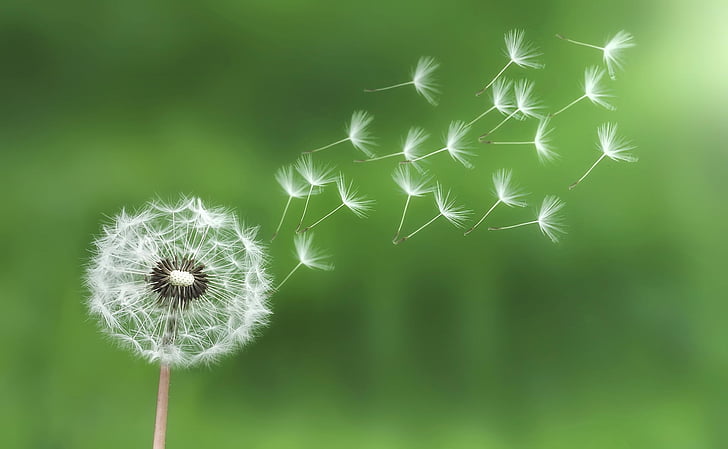
We might even want to find a dandelion that’s ready to seed and then take a deep breath, make a wish, and blow. Not that I believe the superstition that dandelions can grant wishes, but it still seems worthwhile to take a moment to find hope while wishing for something good.
Get more like this—Sign up for our daily inspirational newsletter for exclusive content!
__
Photos: Lauren Wesp; Public Domain Image Courtesy of Science History Institute; Martina Hyblova via PublicDomainPictures.net; Royalty-Free Photos 1 & 2 via PickPik
